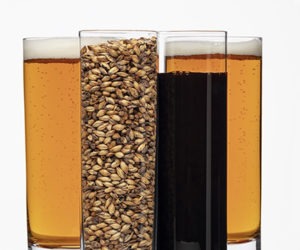What is Brewing?
Brewing is the process of making beer — a fermented, alcoholic beverage made from grains. The most commonly used grain for brewing is barley, but there are others (including wheat, rye, oats and sorghum). Brewing is similar in some ways to making wine, which is a fermented alcoholic beverage made from fruits (most often grapes) or mead, which is fermented honey. However, the brewing process has its own unique elements as well.
You can think of beer as a beverage made from (essentially) four ingredients using four main steps. The ingredients in beer are malt, hops, yeast and water and the four steps are malting, mashing, boiling and fermenting.
The Four Ingredients
Malt Malt is a grain that has been prepared for brewing (by a process called, not surprisingly, malting). Malted barley is the most common base grain used in beer, but malted wheat is also prevalent. In some beers, unmalted ingredients — including corn and rice — are used. Malt provides the sugar that the yeast consume during the brewing process and therefore determines the strength of the beer. More malt equals stronger beer. Most homebrewers, or professional brewers for that matter, do not malt their own grains. They simply purchase malt produced by maltsters or they use malt extract, a more highly processed form of malt.
Hops Hops provide the bitterness to balance the sweetness in beer. Compared to malt, hops are added in small quantities to beer, even in the most bitter IPAs. Most homebrewers use pelletized hops in their brewing as this is a convenient form to store and use.
Yeast Yeast converts the unfermented beer (called wort) that brewers make on brewing day into beer. They consume sugars from the malt and convert them to alcohol and carbon dioxide. Alcohol is, of course, what gives beer its “kick” and carbon dioxide is what gives beer its fizz.
Water Most beers are over 90% water by volume. And, quite a bit of water is used in the brewing process that does not end up in beer. A basic (although not infallible) rule of thumb in homebrewing is, if your water tastes good, it’s suitable for brewing. If your tap water doesn’t taste good, try using bottled spring water instead.
The Four Steps
Malting As mentioned before, malting is usually done by maltsters. However, malting begins the process of converting raw materials into beer and we’d be remiss if we didn’t mention it. In malting, naturally-occurring enzymes in the grains are activated so they can be used for the next step, malting. Then, the grains are dried by heating (called kilning). Kilning dries the grains, which allows them to be stored for long periods of time, and also develops malt flavors and aromas that get extracted in the brewing process.
Mashing In mashing, malted grains are soaked in hot water. In the process, the starch molecules in the grains are dissolved in the hot liquid and the enzymes (activated by the maltster) chop the large starch molecules into smaller molecules of sugar. The main sugar produced in the process of mashing is maltose. Malt sugars from the mash are what fuel the yeast cells during fermentation.
For homebrewers who brew with extract, this process has been done for them. Malt extract is made from malted grains that have been mashed. The resulting liquid is then condensed into syrup or dried into a powder.
Boiling (and Cooling) The solution of water, malt sugars and other substances from the malt is called wort (or unfermented beer). Before wort can be fermented, it must be boiled. Boiling sanitizes the wort and helps to make the finished beer a more stable product. During the boil, the hops are added to the wort and bitter compounds are extracted from them. After the boiling, the wort is cooled so that yeast can be added.
Fermenting (and Conditioning) Once the wort is cooled, yeast is added to it. After a short time in which the yeast acclimate to the wort, fermentation begins. For homebrewers making average-strength ales, fermentation will last from a few days to a week. For brewers making stronger beers or lagers, fermentation can last longer, up to months. After the beer has fully fermented (and sometimes conditioned for awhile), it is ready to be bottled (or kegged) and served.
Homebrewing Equipment
In order to make homebrew, you will need a small amount of specialized equipment. Most homebrew shops sell starter kits, consisting of a bucket fermenter and some other basic equipment, starting at around $60 (US). In the “how to” chapters in this guide, the equipment you need is listed for each method. The more complex the brewing method the more equipment you will tend to need. You will also need a large pot to boil your wort in. A 5-gallon (19 L) stainless steel pot is a great one to start brewing in and these can be found starting at around $40 (US) in many homebrew shops.


